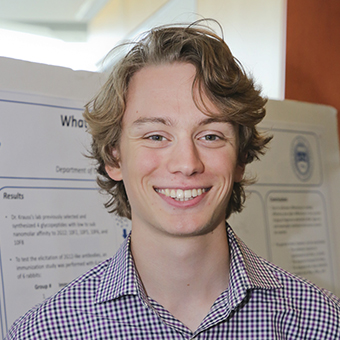Christopher Armstrong
 Krauss Laboratory
Krauss Laboratory
Department of Chemistry
Brandeis University
What Are Our Antibodies Binding to? Evolving an HIV Vaccine
Poster Abstract
Recent HIV vaccine research has focused on broadly neutralizing antibodies (bnAbs), which neutralize a wide breadth of HIV strains. One such bnAb, 2G12, binds to a conserved cluster of (GlcNAc)2-Man9 glycans on gp120, a trimeric glycopeptide on HIV’s envelope. To elicit bnAb production in vivo, a library of glycopeptide mimics was synthesized via solid-phase peptide synthesis and a CuAAC reaction between L-Homopropargylglycines in the peptide and Man9-cyclohexyl-azide. The few mimics that were bound tightly by 2G12 were conjugated to a carrier protein and then used to immunize rabbits, hypothesizing that 2G12-like antibodies would result. Yet the polyclonal serum of the rabbits exhibited low binding to (GlcNAc)2-Man9. To determine what the elicited antibodies in the serum were binding to, the rabbit serum was tested against different fragments of the mimics. Indirect ELISA revealed that there is a strong antibody response against the core of the mimics: triazol-cyclohexyl-Man2, which is largely unnatural. Moving forward, refinement of this unnatural linkage to a less immunogenic form may increase the production of antibodies to Man9; antibodies that may bind better to (GlcNAc)2-Man9.
Personal Statement
As a rising sophomore, this summer was a headfirst dive into research. While I had started working in the Krauss Lab in January, the ball didn’t start rolling until this summer, when I was awarded an M.R. Bauer Fellowship. With more time to learn the necessary immunology and chemistry, as well as read the key papers, the tediousness of pipetting came into a whole new light. In addition to building a context for my research, I developed a greater connection with both the material itself and the other members in our lab. Spending all my time in lab this summer truly helped me build an academic home in chemical biology and a personal home in the Edison-Lecks building.
As I look back on this opportunity, I see that another unexpected effect to this summer’s work is how my research interests have shifted. When the summer began, I was more interested in the application of science; hence my joining Dr. Krauss’s lab to work on vaccine design. Now I feel more inclined to do basic, curiosity-based, research. I find myself wondering less about how to get stuff to bind to sugars on HIV and more about why those sugars are there in the first place. In this regard, my interest in immunology has certainly been piqued. Because I’m also interested in physics and chemistry, this is opening some fascinating doors as to what I can do in the future.